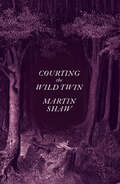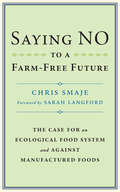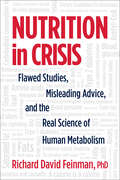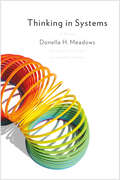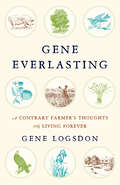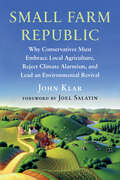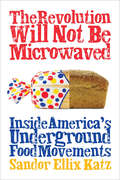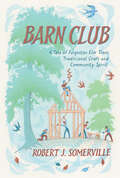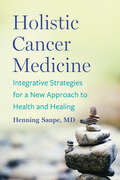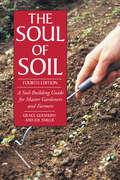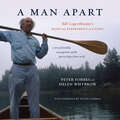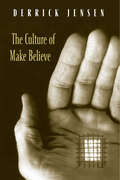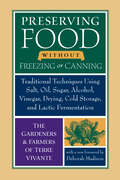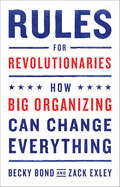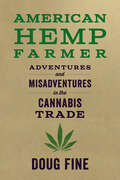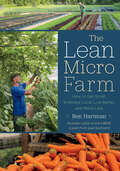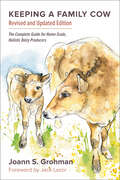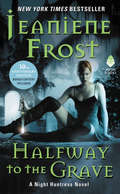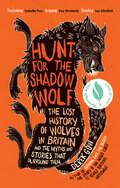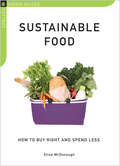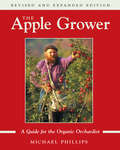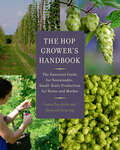- Table View
- List View
Courting the Wild Twin
by Martin Shaw"Fabulous."—Dan Richards, author of Holloway"Terrifically strange and thrilling."—Melissa Harrison, author of All Among the Barley"A modern-day bard."—Madeline Miller, author of CirceThis is a book of literary activism – an antidote to the shallow thinking that typifies our age. In Courting the Wild Twin, acclaimed scholar, mythologist and author of Smoke Hole and Bardskull, Martin Shaw unravels two ancient European fairy tales concerning the mysterious &‘wild twin&’ located deep inside all of us. By reading these tales and becoming storytellers ourselves, he challenges us to confront modern life with purpose, courage, and creativity.Martin summons the reader to the "ragged edge of the dark wood" to seek out this estranged, exiled self – the part we generally shun or ignore to conform to societal norms – and invite it back into our consciousness. If there was something we were meant to do with our few, brief years on Earth, we can be sure that our wild twin is holding the key.After all, stories are our secret weapons – and they might just save us.
Saying NO to a Farm-Free Future: The Case For an Ecological Food System and Against Manufactured Foods
by Chris Smaje&“Everyone in the food business needs to read this book. . . . [A] lively and superbly written polemic.&”—Joel Salatin, co-founder of Polyface FarmNamed the Inc. Non-Obvious Book Awards "Best Books of 2023"A defense of agroecological, small-scale farming and a robust critique of an industrialized future.One of the few voices to challenge The Guardian's George Monbiot on the future of food and farming (and the restoration of nature) is academic, farmer and author of A Small Farm Future Chris Smaje. In Saying NO to a Farm-Free Future, Smaje presents his defense of small-scale farming and a robust critique of Monbiot&’s vision for an urban and industrialized future.Responding to Monbiot&’s portrayal of an urban, high-energy, industrially manufactured food future as the answer to our current crises, and its unchallenged acceptance within the environmental discourse, Smaje was compelled to challenge Monbiot&’s evidence and conclusions. At the same time, Smaje presents his powerful counterargument – a low-carbon agrarian localism that puts power in the hands of local communities, not high-tech corporates.In the ongoing fight for our food future, this book will help you to understand the difference between a congenial, ecological living and a dystopian, factory-centered existence. A must-read!"Chris Smaje has laid down an indictment – as unremitting as it is undeniable – that cuts through the jargon-filled, techno-worshipping agricultural futurists who promise silver-bullet fixes for having your cake and eating it too. This brilliant and compelling book is at once hopeful and persuasive about the future of food."—Dan Barber, chef at Blue Hill and author of The Third Plate
Nutrition in Crisis: Flawed Studies, Misleading Advice, and the Real Science of Human Metabolism
by Richard David FeinmanAlmost every day it seems a new study is published that shows you are at risk for diabetes, cardiovascular disease, or death due to something you&’ve just eaten for lunch. Many of us no longer know what to eat or who to believe. In Nutrition in Crisis distinguished biochemist Richard Feinman, PhD, cuts through the noise, explaining the intricacies of nutrition and human metabolism in accessible terms. He lays out the tools you need to navigate the current confusion in medical literature and its increasingly bizarre reflection in the media.At the same time, Nutrition in Crisis offers an unsparing critique of the nutritional establishment, which continues to demonize fat and refute the benefits of low-carbohydrate and ketogenic diets—all despite decades of evidence to the contrary. Feinman tells the story of the first low-carbohydrate revolution fifteen years ago, how it began, what killed it, and why a second revolution is now reaching a fever pitch. He exposes the backhanded tactics of a regressive nutritional establishment that ignores good data and common sense, and highlights the innovative work of those researchers who have broken rank.Entertaining, informative, and irreverent, Feinman paints a broad picture of the nutrition world: the beauty of the underlying biochemistry; the embarrassing failures of the medical establishment; the preeminence of low-carbohydrate diets for weight loss, diabetes, other metabolic diseases, and even cancer; and what&’s wrong with the constant reports that the foods we&’ve been eating for centuries represent a threat rather than a source of pleasure.
Thinking in Systems: International Bestseller
by Donella MeadowsThe classic book on systems thinking—with more than half a million copies sold worldwide!&“This is a fabulous book… This book opened my mind and reshaped the way I think about investing.&”—Forbes&“A modern classic&”—The New YorkerIn the years following her role as the lead author of the international bestseller, Limits to Growth—the first book to show the consequences of unchecked growth on a finite planet—Donella Meadows remained a pioneer of environmental and social analysis until her untimely death in 2001.Thinking in Systems is a concise and crucial book offering insight for problem solving on scales ranging from the personal to the global. Edited by the Sustainability Institute&’s Diana Wright, this essential primer brings systems thinking out of the realm of computers and equations and into the tangible world, showing readers how to develop the systems-thinking skills that thought leaders across the globe consider critical for 21st-century life.Some of the biggest problems facing the world—war, hunger, poverty, and environmental degradation—are essentially system failures. They cannot be solved by fixing one piece in isolation from the others, because even seemingly minor details have enormous power to undermine the best efforts of too-narrow thinking.While readers will learn the conceptual tools and methods of systems thinking, the heart of the book is grander than methodology. Donella Meadows was known as much for nurturing positive outcomes as she was for delving into the science behind global dilemmas. She reminds readers to pay attention to what is important, not just what is quantifiable, to stay humble, and to stay a learner.In a world growing ever more complicated, crowded, and interdependent, Thinking in Systems helps readers avoid confusion and helplessness, the first step toward finding proactive and effective solutions.&“Thinking in Systems is required reading for anyone hoping to run a successful company, community, or country. Learning how to think in systems is now part of change-agent literacy. And this is the best book of its kind.&”—Hunter Lovins
Gene Everlasting: A Contrary Farmer's Thoughts on Living Forever
by Gene LogsdonAuthor Gene Logsdon—whom Wendell Berry once called &“the most experienced and best observer of agriculture we have&”—has a notion: That it is a little easier for gardeners and farmers to accept death than the rest of the populace. Why? Because every day, farmers and gardeners help plants and animals begin life and help plants and animals end life. They are intimately attuned to the food chain. They understand how all living things are seated around a dining table, eating while being eaten. They realize that all of nature is in flux.Gene Everlasting contains Logsdon&’s reflections, by turns both humorous and heart-wrenching, on nature, death, and eternity, all from a contrary farmer&’s perspective. He recounts joys and tragedies from his childhood in the 1930s and &‘40s spent on an Ohio farm, through adulthood and child-raising, all the way up to his recent bout with cancer, always with an eye toward the lessons that farming has taught him about life and its mysteries.Whether his subject is parsnips, pigweed, immortality, irises, green burial, buzzards, or compound interest, Logsdon generously applies as much heart and wit to his words as he does care and expertise to his fields.
Small Farm Republic: Why Conservatives Must Embrace Local Agriculture, Reject Climate Alarmism, and Lead an Environmental Revival
by John Klar&“I have read at least 20 books a year for the past 25 years and Small Farm Republic is absolutely one of the very best that I have ever read. . . A must-read not only for those involved in all facets of agriculture but policy makers and consumers as well.&”—Gabe Brown, regenerative rancher, author of Dirt to SoilFrom farmer, lawyer, and political activist John Klar comes a bold, solutions-based plan for Conservatives that gets beyond the fatuous pipe dreams and social-justice platitudes of the dominant, Liberal &“Green&” agenda—offering a healthy way forward for everyone.While many on the Left have taken up the mantle of creating a &“green&” future through climate alarmism, spurious new energy sources, and technocratic control, many on the Right continue to deny imminent environmental threats while pushing for unbridled deregulation of our most destructive industrial forces. Neither approach promises a bright future.In a time of soil degradation, runaway pollution, food insecurity, and declining human health, the stakes couldn&’t be higher, and yet the dominant political voices too often overlook the last best hope for our planet—supporting small, regenerative farmers. In fact, politicians on all sides continue to sell out the interests of small farmers to the devastating power of Big Ag and failed &“renewable energy&” incentives. It&’s time for a new vision. It&’s time for bold new agriculture policies that restore both ecosystems and rural communities.In Small Farm Republic, John Klar, an agrarian conservative in the mold of Wendell Berry and Joel Salatin, offers an alternative that puts small farmers, regenerative agriculture, and personal liberty at the center of an environmental revival—a message that everyone on the political spectrum needs to hear.
The Revolution Will Not Be Microwaved: Inside America's Underground Food Movements
by Sandor Ellix KatzFrom James Beard Award winner and New York Times–bestselling author of The Art of FermentationAn instant classic for a new generation of monkey-wrenching food activists.Food in America is cheap and abundant, yet the vast majority of it is diminished in terms of flavor and nutrition, anonymous and mysterious after being shipped thousands of miles and passing through inscrutable supply chains, and controlled by multinational corporations. In our system of globalized food commodities, convenience replaces quality and a connection to the source of our food. Most of us know almost nothing about how our food is grown or produced, where it comes from, and what health value it really has. It is food as pure corporate commodity. We all deserve much better than that.In The Revolution Will Not Be Microwaved, author Sandor Ellix Katz (Sandor Katz's Fermentation Journeys, The Art of Fermentation, and Wild Fermentation) profiles grassroots activists who are taking on Big Food, creating meaningful alternatives, and challenging the way many Americans think about food. From community-supported local farmers, community gardeners, and seed saving activists, to underground distribution networks of contraband foods and food resources rescued from the waste stream, this book shows how ordinary people can resist the dominant system, revive community-based food production, and take direct responsibility for their own health and nutrition.
Barn Club: A Tale of Forgotten Elm Trees, Traditional Craft and Community Spirit
by Robert Somerville&“In today&’s ego-techno-centred world, Robert Somerville&’s . . . Barn Club approach is a way forward that utilizes local traditions, local materials, and local hands to create a built environment that is more harmonious with the natural world and of course more beautiful.&”—Jack A. Sobon, architect, timber framer, and author of Hand Hewn&“Somerville knows more about wooden barn construction than almost anyone alive.&”—The TelegraphNatural history meets traditional hand craft in this celebration of the elm tree and community spirit.When renowned craftsman Robert Somerville moved to Hertfordshire in southern England, he discovered an unexpected landscape rich with wildlife and elm trees. Nestled within London&’s commuter belt, this wooded farmland inspired Somerville, a lifelong woodworker, to revive the ancient tradition of hand-raising barns.Barn Club follows the building of Carley Barn over the course of one year. Volunteers from all walks of life joined Barn Club, inspired to learn this ancient skill of building elm barns by hand, at its own quiet pace and in the company of others, while using timber from the local woods.The tale of the elm tree in its landscape is central to Barn Club. Its natural history, historic importance, and remarkable survival make for a fascinating story.This is a tale of forgotten trees, a local landscape, and an ancient craft.This book includes sixteen pages of color photographs, and black and white line drawings of techniques and traditional timber frame barns feature throughout.Perfect for fans of Norwegian Wood and The Hidden Life of Trees.
Holistic Cancer Medicine: Integrative Strategies for a New Approach to Health and Healing
by Henning Saupe*As Seen on Chris Beat CancerA groundbreaking, comprehensive guide on managing, treating, and preventing cancer.*Introducing: The Holistic Model of the Twelve Vital Fields*It&’s a sad truth of our times that one in three people will experience cancer in their lifetime. By 2040, the probability will rise to one in two. As a comprehensive guide on natural treatment, Holistic Cancer Medicine is essential reading for every cancer patient—from newly diagnosed to late stage. For those seeking to prevent the disease, it also provides key information on how to reduce your risks.As the founder and director of Germany&’s leading complementary cancer clinic, Dr. Henning Saupe offers Holistic Cancer Medicine as the culmination of twenty-five years of experience treating the disease. Dr. Saupe&’s unique vantage and insight complements standard treatment models with less burdensome, less invasive, and more natural methods. His program focuses on how those affected by cancer can carry out treatment to cure or control the disease while maintaining a high quality of life.Other topics include:The revolutionary Holistic Model of the Twelve Vital FieldsThe dynamic interplay between nutrition, circulation, the microbiome, mitochondrial health, acid-base balance, and chronic infections, and moreSpecific tumor-killing methods, such as insulin potentiation therapy (IPT), photodynamic therapy (PDT), local and whole-body hyperthermia, and pulsating electromagnetic frequency therapy (PEMF)Inner-life training (ILT) and affirmations for both physical and emotional painTools for those accompanying relatives, friends, or colleagues through the stages of cancerAnd much moreHolistic Cancer Medicine is a groundbreaking book for a critical time of life with an essential and compassionate message: that a diagnosis of cancer and living a vibrant life are not mutually exclusive.&“Dr. Saupe&’s comprehensive new book shows that there is so much a person can do to treat and prevent cancer in addition to conventional medicine. If you want to gain a thorough understanding of cancer cells and the immune system, I highly recommend Holistic Cancer Medicine.&”—Kelly A. Turner, PhD, New York Times bestselling author of Radical Hope and Radical Remission
The Soul of Soil: A Soil-Building Guide for Master Gardeners and Farmers, 4th Edition
by Grace Gershuny Joseph SmillieSoil is the basis not only for all gardening, but for all terrestrial life. No aspect of agriculture is more fundamental and important, yet we have been losing vast quantities of our finite soil resources to erosion, pollution, and development.Now back in print, this eminently sensible and wonderfully well-focused book provides essential information about one of the most significant challenges for those attempting to grow delicious organic vegetables: the creation and maintenance of healthy soil.Chapter 2, &“Understanding the Soil System,&” is alone worth the price of admission. Gershuny and Smillie give lay readers and experts a clear explanation of subjects–soil life and nutrient cycles–that have confounded most authors. Nowhere will the reader find simpler and more coherent descriptions of key concepts including cation exchange capacity and chelation.There are other books about soil available, including Grace Gershuny&’s comprehensive Start with the Soil, and there are books that feature chapters on soil building. What distinguishes The Soil of Soilis the authors&’ concise presentation; they give readers important information, including technical essentials, without getting bogged down in scientific or quasiscientific mumbo-jumbo. In addition, useful tables list specific compost materials, green manures, and other resources that allow growers to translate into action the more general information provided by the book.The soil-building techniques featured include:Organic matter managementBuilding and maintaining humusOn-site compostingGreen manures and rotationsCultivation and weed controlNutrient balances and soil testingUsing mineral fertilizersPlanning for organic certificationUpdates to this edition include analysis of Proposed Rules for the National Organic Standards, and expanded recommendations for private testing services and soil-testing equipment for home gardeners and organic farmers.All of us involved in the cultivation of plants–from the backyard gardener to the largest farmer–need to help regenerate a &“living soil,&” for only in the diversity of the soil and its creatures can we ensure the long-term health of ourselves and our environment. The Soul of Soil offers everyone a basic understanding of what soil is and what we can do to improve our own patch of it. Seen in this light, this practical handbook will be an inspiration as well.
A Man Apart: Bill Coperthwaite's Radical Experiment in Living
by Peter Forbes Helen WhybrowA story of friendship, encouragement, and the quest to design a better worldA Man Apart is the story—part family memoir and part biography—of Peter Forbes and Helen Whybrow&’s longtime friendship with Bill Coperthwaite (A Handmade Life), whose unusual life and fierce ideals helped them examine and understand their own.Coperthwaite inspired many by living close to nature and in opposition to contemporary society, and was often compared to Henry David Thoreau. Much like Helen and Scott Nearing, who were his friends and mentors, Coperthwaite led a 55-year-long &“experiment in living&” on a remote stretch of Maine coast. There he created a homestead of wooden, multistoried yurts, a form of architecture for which he was known around the world.Coperthwaite also embodied a philosophy that he called &“democratic living,&” which was about empowering all people to have agency over their lives in order to create a better community. The central question of Coperthwaite&’s life was, &“How can I live according to what I believe?&”In this intimate and honest account—framed by Coperthwaite&’s sudden death and brought alive through the month-long adventure of building with him what would turn out to be his last yurt—Forbes and Whybrow explore the timeless lessons of Coperthwaite&’s experiment in intentional living and self-reliance. They also reveal an important story about the power and complexities of mentorship: the opening of one&’s life to someone else to learn together, and carrying on in that person&’s physical absence.While mourning Coperthwaite&’s death and coming to understand the real meaning of his life and how it endures through their own, Forbes and Whybrow craft a story that reveals why it&’s important to seek direct experience, to be drawn to beauty and simplicity, to create rather than critique, and to encourage others.
The Culture of Make Believe
by Derrick JensenDerrick Jensen takes no prisoners in The Culture of Make Believe, his brilliant and eagerly awaited follow-up to his powerful and lyrical A Language Older Than Words. What begins as an exploration of the lines of thought and experience that run between the massive lynchings in early twentieth-century America to today's death squads in South America soon explodes into an examination of the very heart of our civilization. The Culture of Make Believe is a book that is as impeccably researched as it is moving, with conclusions as far-reaching as they are shocking.
Preserving Food without Freezing or Canning: Traditional Techniques Using Salt, Oil, Sugar, Alcohol, Vinegar, Drying, Cold Storage, and Lactic Fermentation
by Chelsea Green Publishing CompanyMore than 250 easy and enjoyable recipes!&“The methods here [will] inspire us with their resourcefulness, their promise of goodness, and with the idea that we can eat well year around.&”—Deborah MadisonOver 100,00 copies sold!Typical books about preserving garden produce nearly always assume that modern &“kitchen gardeners&” will boil or freeze their vegetables and fruits. Yet here is a book that goes back celebrating traditional but little-known French techniques for storing and preserving edibles in ways that maximize flavor and nutrition.Translated into English, and with a new foreword by Deborah Madison, this book deliberately ignores freezing and high-temperature canning in favor of methods that are superior because they are less costly and more energy-efficient.Inside, you&’ll learn how to:Preserve without nutrient lossPreserve by dryingPreserve with oil, vinegar, salt, and sugarMake sweet-and-sour preservesPreserve with alcoholAs Eliot Coleman says in his foreword to the first edition, &“Food preservation techniques can be divided into two categories: the modern scientific methods that remove the life from food, and the natural &‘poetic&’ methods that maintain or enhance the life in food. The poetic techniques produce… foods that have been celebrated for centuries and are considered gourmet delights today.&”Preserving Food Without Freezing or Canning offers more than 250 easy and enjoyable recipes featuring locally grown and minimally refined ingredients.An essential guide for those who seek healthy food for a healthy world.
Rules for Revolutionaries: How Big Organizing Can Change Everything
by Becky Bond Zack ExleyLessons from the groundbreaking grassroots campaign that helped launch a new political revolutionRules for Revolutionaries is a bold challenge to the political establishment and the &“rules&” that govern campaign strategy.It tells the story of a breakthrough experiment conducted on the fringes of the Bernie Sanders presidential campaign: A technology-driven team empowered volunteers to build and manage the infrastructure to make seventy-five million calls, launch eight million text messages, and hold more than one-hundred thousand public meetings—in an effort to put Bernie Sanders&’s insurgent campaign over the top.Bond and Exley, digital iconoclasts who have been reshaping the way politics is practiced in America for two decades, have identified twenty-two rules of &“Big Organizing&” that can be used to drive social change movements of any kind. And they tell the inside story of one of the most amazing grassroots political campaigns ever run.Fast-paced, provocative, and profound, Rules for Revolutionaries stands as a liberating challenge to the low expectations and small thinking that dominates too many advocacy, non-profit, and campaigning organizations—and points the way forward to a future where political revolution is truly possible.
American Hemp Farmer: Adventures and Misadventures in the Cannabis Trade
by Doug FineThe inside story of the world&’s most fascinating and lucrative crop from gonzo journalist–turned–hemp farmer Doug Fine.Hemp, the non-psychoactive variant of cannabis (or marijuana) and one of humanity&’s oldest plant allies, has quietly become the fastest industry ever to generate a billion dollars of annual revenue in North America. From hemp seed to hemp fiber to the currently ubiquitous cannabinoid CBD, this resilient crop is leading the way toward a new, regenerative economy that contributes to soil and climate restoration—but only if we do it right.In American Hemp Farmer, maverick journalist and solar-powered goat herder Doug Fine gets his hands dirty with healthy soil and sticky with terpenes growing his own crop and creating his own hemp products. Fine shares his adventures and misadventures as an independent, regenerative farmer and entrepreneur, all while laying out a vision for how hemp can help right the wrongs of twentieth-century agriculture, and how you can be a part of it.
The Lean Micro Farm: How to Get Small, Embrace Local, Live Better, and Work Less
by Ben Hartman&“Ben Hartman is a true innovator for the small farm.&”—Curtis Stone, author of The Urban FarmerIt&’s time to think big about small farms. Award-winning author and &“green leader&” (Grist) Ben Hartman shares practical how-to tips, personal stories, and surprising examples of cutting-edge farmers and innovators around the world to show us how.In the early 1970s, US Agriculture Secretary Earl Butz infamously commanded farmers to &“get big or get out.&” In The Lean Micro Farm, author Ben Hartman rejects that disastrous suggestion and instead takes up the charge of the late agrarian thinker Gene Logsdon: &“Get small and stay in.&”Taking inspiration from the groundbreaking ideas of E. F. Schumacher and Mahatma Gandhi, The Lean Micro Farm shows how small, hyperlocal farms can be both ecologically and economically superior to industrial-scale operations geared toward export and commodity markets.The Lean Micro Farm details the author&’s remarkable journey to downsize his farm from one acre to a third of an acre in an effort to prioritize family and community over work, all without taking a pay cut. In addition, Hartman profiles six innovative farmers from across the globe who embody this &“get small&” mindset. These pioneering farmers show all of us a path toward resilience in the face of supply chain disruption, globalization, and climate change. They model a gentler, more ecological approach to farming that produces less waste and uses less plastic, petroleum, and fertilizer.Like his previous two books, The Lean Farm and The Lean Farm Guide to Growing Vegetables, Hartman&’s The Lean Micro Farm doesn&’t just explain why smaller is better, it shows readers exactly how it can be done with step-by-step guides on how to turn a profit from a tiny, but productive, parcel of farmland. Readers will find not just philosophical justifications for a minimalist approach to agriculture but also actionable information for starting your own profitable micro farm, including:A description of the &“deep mulch&” method for building fertilityInstructions on two-step bed flipping to increase production on a small footprintA guide for choosing essential tools and technologies &“with a human face&”An easy-to-follow process for making your micro farm lean and efficientA detailed plan for selling $20,000 worth of produce from your backyardIt&’s time, Hartman makes clear, to pivot to a new kind of farming—one that builds upon ancestral knowledge, nourishes communities, and puts human joy, not technology, at its center.&“Hartman has revolutionized his methods, cut down his work hours dramatically, and shrunk the size of his farm, all while making a better income.&”—Civil Eats
Keeping a Family Cow: The Complete Guide for Home-Scale, Holistic Dairy Producers, 3rd Edition
by Joann S. GrohmanThe cow is the most productive, efficient creature on earth. She will give you fresh milk, cream, butter, and cheese, build human health and happiness, and even turn a profit for homesteaders and small farmers who seek to offer her bounty to the local market or neighborhood. She will provide rich manure for your garden or land, and will enrich the quality of your life as you benefit from the resources of the natural world. Quite simply, the family that keeps a cow is a healthy family.Originally published in the early 1970s as The Cow Economy and reprinted many times over, Keeping a Family Cow has launched thousands of holistic small-scale dairy farmers and families raising healthy cows in accordance with their true nature. The book offers answers to frequently asked questions like, &‘Should I get a cow?&’ and &‘How Much Space do I need?&’ in addition to extensive information on:• The health benefits of untreated milk;• How to milk a cow effectively and with ease;• Choosing your dairy breed;• Drying off your cow;• Details on calving and breeding;• The importance of hay quality and how to properly feed your cow;• Fencing and pasture management;• Housing, water systems, and other supplies;• Treating milk fever and other diseases and disorders;• Making butter, yogurt, and cheese, and, of course . . .• . . . Everything else the conventional dairy industry doesn&’t tell us!Now revised and updated to incorporate new information on the raw milk debate, the conversation about A1 vs. A2 milk, fully grassfed dairies, more practical advice for everyday chores, and updated procedures for cow emergencies.Keeping a Family Cow has not only stood the test of time, it still remains the go-to inspirational manual for raising a family milk cow nearly forty years after its first publication. Joann Grohman has a lifetime of practical experience that has been bound into this one volume and presented in the spirit of fun and learning.
Halfway to the Grave: A Night Huntress Novel (Night Huntress #1)
by Jeaniene FrostMeet the vampire world's supercouple Cat and Bones in this special 10th anniversary edition, with a "director's cut" collection of deleted scenes!"Cat and Bones are combustible together." - Charlaine HarrisHalf-vampire Catherine Crawfield is going after the undead with a vengeance, hoping that one of these deadbeats is her father—the one responsible for ruining her mother's life. Then she's captured by Bones, a vampire bounty hunter, and is forced into an unholy partnership.In exchange for finding her father, Cat agrees to train with the sexy night stalker until her battle reflexes are as sharp as his fangs. She's amazed she doesn't end up as his dinner—are there actually good vampires? Pretty soon Bones will have her convinced that being half-dead doesn't have to be all bad. But before she can enjoy her newfound status as kick-ass demon hunter, Cat and Bones are pursued by a group of killers. Now Cat will have to choose a side . . . and Bones is turning out to be as tempting as any man with a heartbeat.
Hunt for the Shadow Wolf: The lost history of wolves and the myths and stories that surround them
by Derek GowLonglisted for the James Cropper Wainwright Prize 2024 for Nature Writing"Terrific, life-lit moments come howling out of Hunt for the Shadow Wolf."—The Telegraph"One of the most remarkable figures in British conservation."—The Observer"There have been several books on the fate of British wolves, but this is the best."—The Spectator"[Derek Gow is] a wry, profane truth teller who is equal parts yeoman farmer, historical ecologist, and pirate."—Ben Goldfarb, author of Eager and CrossingsRenowned rewilder Derek Gow has a dream: that one day we will see the return of the wolf to Britain as it has already returned elsewhere. As Derek worked to reintroduce the beaver, he began to hear stories of the wolf, both real and mythical, and his fascination with this creature grew. With increasing curiosity, Derek started to piece together fragments of information, stories and artefacts to reveal a shadowy creature that first walked proud through these lands and then was hunted to extinction as coexistence turned to fear, hatred – and domination.What Derek came to realize was that the underlying motives behind our hatred were actually far more prosaic and, like most persecutions, to do with power and profit. We turned the wolf into a savage beast and saw its extirpation as a civilizing mission. But the wolf survived far longer than many thought and Derek tells of his sightings of the wolf through folklore and mythology, the records of grand estates and parish churches as well as wolf heads, both real and recreated.With bitingly funny but also tender stories, Hunt for the Shadow Wolf is Derek&’s quest to uncover the true nature of this creature because, as we seek to heal our landscape, we must reconcile our relationship with it. Before we can even begin to bring the wolf back, we need to understand it."I have loved this chase dearly and though what unfolds might be an ending of sorts, I have no intention to let this hunt cease."―Derek Gow, from Hunt for the Shadow Wolf"Beautifully crafted, fascinating and unbearably poignant, I totally loved this book."—Isabella Tree, author of Wilding"Gow reinvents what it means to be a guardian of the countryside."—The Guardian
Compost, Vermicompost and Compost Tea: Feeding the Soil on the Organic Farm
by Grace GershunyWhat are the advantages of making one's own compost? Is there really a benefit to using compost as opposed to building soil organic matter through other means? How can the decision about compost making affect a farm's economics? Part of the NOFA Guides series, this manual will help answer these questions, and is specifically intended to address the conditions faced by organic farmers in the Northeast.Information on composting techniques, including:Principles and biology of compostingTemperature, aeration and moisture controlComposting methodsMaterials (additives and inoculants, biodynamic preparations)About costs (site preparation, equipment, labor and time)What do you do with it?Compost tea and other brewed microbial culturesCompost and the lawWith extended appendices including a recipe calculator, potting mix recipes, and a sample compost production budget sheet.
Bringing Back the Beaver: The Story of One Mans Quest to Rewild Britains Waterways
by Derek Gow&“Derek Gow might be the most colorful character in all of Beaverdom.&”—Ben Goldfarb, author of Eager"Gow&’s triumph has been the reintroduction of the Eurasian beaver."—The New YorkerBringing Back the Beaver is farmer-turned-ecologist Derek Gow&’s inspirational and often riotously funny firsthand account of how the movement to rewild the British landscape with beavers has become the single most dramatic and subversive nature conservation act of the modern era. Since the early 1990s—in the face of outright opposition from government, landowning elites, and even some conservation professionals—Gow has imported, quarantined, and assisted the reestablishment of beavers in waterways across England and Scotland.In addition to detailing the ups and downs of rewilding beavers, Bringing Back the Beaver makes a passionate case as to why the return of one of nature&’s great problem solvers will be critical as part of a sustainable fix for flooding and future drought, whilst ensuring the creation of essential lifescapes that enable the broadest possible spectrum of Britain&’s wildlife to thrive.&“Bringing Back the Beaver is a hilarious, eccentric and magnificent account of a struggle . . . to reintroduce a species crucial to the health of our ecosystems.&”—George Monbiot&“A treasure.&”—Booklist
Sustainable Food: How to Buy Right and Spend Less
by Elise McdonoughWondering whether it&’s worth it to splurge on the locally raised beef? What about those organic carrots? New in the Chelsea Green Guides series, Sustainable Food: How to Buy Right and Spend Less helps the average shopper navigate the choices, whether strolling the aisles of a modern supermarket or foraging at a local farmers market.This down-to-earth, casual guide—small enough to be slipped into your pocket—answers these and other questions for the shopper:What are the differences among organic, local, fair-trade, free-range, naturally raised, and biodynamic foods?How affordable is it to subscribe to a CSA farm—and what are the advantages?Is it better to choose wild Alaskan salmon at $18.99, or the Chilean farmed fish at $11.99?What cooking oils can be sustainably sourced?How can a food co-op increase access to, and affordability of, healthier, Earth-friendly foods?Where can you find sustainably produced sugar, and are there any local replacements for sweeteners from faraway lands?What do the distinctions between shade-grown and trellised coffee mean?Is shark okay to eat? How about mackerel?Why is the war on plastic bags so important?Sustainable eating just got easier.
The Apple Grower: Guide for the Organic Orchardist, 2nd Edition
by Michael PhillipsFor decades fruit growers have sprayed their trees with toxic chemicals in an attempt to control a range of insect and fungal pests. Yet it is possible to grow apples responsibly, by applying the intuitive knowledge of our great-grandparents with the fruits of modern scientific research and innovation.Since The Apple Grower first appeared in 1998, orchardist Michael Phillips has continued his research with apples, which have been called &“organic&’s final frontier.&” In this new edition of his widely acclaimed work, Phillips delves even deeper into the mysteries of growing good fruit with minimal inputs. Some of the cutting-edge topics he explores include:The use of kaolin clay as an effective strategy against curculio and borers, as well as its limitationsCreating a diverse, healthy orchard ecosystem through understory management of plants, nutrients, and beneficial microorganismsHow to make a small apple business viable by focusing on heritage and regional varieties, value-added products, and the &“community orchard&” modelThe author&’s personal voice and clear-eyed advice have already made The Apple Grower a classic among small-scale growers and home orchardists. In fact, anyone serious about succeeding with apples needs to have this updated edition on their bookshelf.
The Seed Detective: Uncovering the Secret Histories of Remarkable Vegetables
by Adam AlexanderMeet the Indiana Jones of vegetables and join him on his quest to save our heritage produce.Named BBC Radio 4's The Food Programme "Book of the Year"2023 GardenComm Media Awards Silver Laurel Medal of AchievementShortlisted for the Garden Media Guild&’s Garden Book of the Year Award 2023Longlisted for The Art of Eating Prize 2023"[This book] is a clarion call to think about our food in new ways and carefully consider where it comes from."—New ScientistDid you ever wonder how peas, kale, asparagus, beans, squash, and corn have ended up on our plates? Well, so did Adam Alexander.Adam Alexander is The Seed Detective. His passion for vegetables was ignited when he tasted an unusual sweet pepper with a fiery heart while on a filmmaking project in Ukraine. Smitten by its flavor, Adam began to seek out local growers of endangered heritage and heirloom varieties in a mission to bring home seeds to grow, share, and return so that he could enjoy their delicious taste—and save them from being lost forever.In The Seed Detective, Adam shares his own stories of seed hunting, with the origin stories behind many of our everyday food heroes. Taking us on a journey that began when we left the life of the hunter-gatherer to become farmers, he tells tales of globalization, political intrigue, colonization, and serendipity—describing how these vegetables and their travels have become embedded in our food cultures.&“We are a nation of vegetable growers and this book explores the wonderful world of rare and endangered heritage and heirloom vegetables – and why we must keep growing them and saving their seed, not only for our gardening and culinary pleasure, but to pass these stories on – vegetables are truly our history on a plate.&”—The Seed Detective"Copious but thoroughly engaging research . . . Alexander shares his excitement over the potential for rescuing this lost heritage. . . All of which makes this title worth a serious look."—Booklist (starred)"[The Seed Detective] traces the origins and evolution of vegetables that have shaped human civilization."—Atlas Obscura&“[A] spirited introduction to the contemporary seed-saving movement. . . . With entertaining anecdotes that feature Syrian fava beans, Ukrainian sweet peppers and broad beans from Myanmar, Alexander's horticultural adventures will surely stimulate and unleash readers' inner gardeners.&”—Shelf Awareness"For Adam Alexander seeds are more than just a job, hobby or passion. They&’re a lifeline."—Modern Farmer
The Hop Grower's Handbook: The Essential Guide for Sustainable, Small-Scale Production for Home and Market
by Laura Ten Eyck Dietrich GehringWith information on siting, planting, tending, harvesting, processing, and brewingIt&’s hard to think about beer these days without thinking about hops. The runaway craft beer market&’s convergence with the ever-expanding local foods movement is helping to spur a local-hops renaissance. The demand from craft brewers for local ingredients to make beer—such as hops and barley—is robust and growing. That&’s good news for farmers looking to diversify, but the catch is that hops have not been grown commercially in the eastern United States for nearly a century. Today, farmers from Maine to North Carolina are working hard to respond to the craft brewers&’ desperate call for locally grown hops. But questions arise: How best to create hop yards—virtual forests of 18-foot poles that can be expensive to build? How to select hop varieties, and plant and tend the bines, which often take up to three years to reach full production? How to best pick, process, and price them for market? And, how best to manage the fungal diseases and insects that wiped out the eastern hop industry 100 years ago, and which are thriving in the hotter and more humid states thanks to climate change? Answers to these questions can be found in The Hop Grower&’s Handbook—the only book on the market about raising hops sustainably, on a small scale, for the commercial craft beer market in the Northeast. Written by hop farmers and craft brewery owners Laura Ten Eyck and Dietrich Gehring, The Hop Grower&’s Handbook is a beautifully photographed and illustrated book that weaves the story of their Helderberg Hop Farm with the colorful history of New York and New England hop farming, relays horticultural information about the unusual hop plant and the mysterious resins it produces that give beer a distinctively bitter flavor, and includes an overview of the numerous native, heirloom, and modern varieties of hops and their purposes. The authors also provide an easy-to-understand explanation of the beer-brewing process—critical for hop growers to understand in order be able to provide the high-quality product brewers want to buy—along with recipes from a few of their favorite home and micro-brewers.The book also provides readers with detailed information on: • Selecting, preparing, and designing a hop yard site, including irrigation;• Tending to the hops, with details on best practices to manage weeds, insects, and diseases; and,• Harvesting, drying, analyzing, processing, and pricing hops for market.The overwhelming majority of books and resources devoted to hop production currently available are geared toward the Pacific Northwest&’s large-scale commercial growers, who use synthetic pesticides, fungicides, herbicides, and fertilizers and deal with regionally specific climate, soils, weeds, and insect populations. Ten Eyck and Gehring, however, focus on farming hops sustainably. While they relay their experience about growing in a new Northeastern climate subject to the higher temperatures and volatile cycles of drought and deluge brought about by global warming, this book will be an essential resource for home-scale and small-scale commercial hops growers in all regions.
